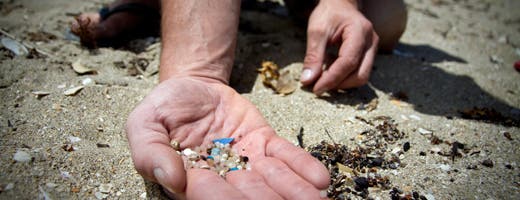A few days ago we were telling you about a study which quantified the amount of plastic in the Earth’s waters – 5.25 trillion pieces which weigh an estimated 269,000 tonnes. But another study found that tens of thousands of plastic (or even more) are actually lying on the bottom of the ocean floor, trapped in mud and sand.

Previous studies have found huge quantities of plastic in the oceans, but even so, what they found was much lower than even conservative estimates… so where is the missing plastic? Analysing samples from 12 sites in the Atlantic Ocean, Mediterranean Sea and Indian Ocean taken between 2001 and 2012 researchers from Great Britain and Spain found what many were already suspecting – the oceanic sediments act like a sink for plastics (especially nanoplastics).
Researchers believe that they are just starting to uncover the extent of the nanoplastics – they believe that as research continues, more and more will be found. Prof Lucy Woodall, of the Natural History Museum in London and the paper’s lead author, said:
“This is the tip of the iceberg. Fibres are ubiquitous in our oceans and they do appear to be quite abundant in comparison with similar studies that have looked at similar things. The fundamental message of the paper is really quite simple: they’re there. Now we need to find out what the impacts are on our environment.”
When we’re talking about nanoplastics on the bottom of the sea, the size we’re talking varies between 2–3 mm in length and is less than 0.1 mm in diameter. They found plastics in virtually all the analyzed sediments; the fact that plastics were so ubiquitous in the analyzed areas suggests that this is also the case in the rest of the oceans on Earth.

“The prevalence of plastic microfibres in all sediment cores and on all coral colonies examined suggests this contaminant is ubiquitous in the deep sea. Furthermore, the wide variety of polymer types detected reveals that the accumulation and deposition of microfibres in the deep sea is complex and that they arise from a variety of domestic and industrial sources,” the study said.
As for the source of the plastic… we are all to blame. The variety of the plastic polymers suggest that the plastics arise from numerous activities.
“Pretty much everything [is a potential source for what we found]. Just look around in our environment, our computers have plastic, our bags have, our cups have. All those things can potentially end up in the ocean, so to pinpoint any particular source is just not possible.”
The abundance of plastic at such depths has potentially negative ramifications for marine life, though the study says more research is needed. “A range of organisms are known to ingest microplastics, and there is concern this could result in physical and/or toxicological harm,” the authors warn.
Journal Reference: Lucy C. Woodall, Anna Sanchez-Vidal, Miquel Canals, Gordon L.J. Paterson, Rachel Coppock, Victoria Sleight, Antonio Calafat, Alex D. Rogers, Bhavani E. Narayanaswamy, Richard C. Thompson. The deep sea is a major sink for microplastic debris. DOI: 10.1098/rsos.140317Published 17 December 2014






